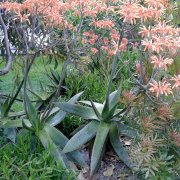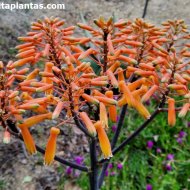Care of the succulent plant Aloe striata or Coral aloe |
|
The genus Aloe is included in the subfamily Asphodeloideae (family Xanthorrhoeaceae), which comprises about 500 species of succulent plants native to Africa, Madagascar and the Middle East. Some species are: Aloe striata, Aloe x caesia, Aloe pluridens, Aloe plicatilis, Aloe mitriformis, Aloe marlothii, Aloe maculata, Aloe juvenna, Aloe ferox, Aloe ciliaris, Aloe barberae, Aloe aristata, Aloe arborescens, Aloe aculeata, Aloe variegata, Aloe vera, Aloe x spinosissima, Aloe x delaetii, Aloe thraskii, Aloe tenuior, Aloe suprafoliata, Aloe esculenta. Common name: Coral aloe. This species is native to South Africa. They are succulent plants with thick rosette leaves with a white border without thorns; the plant does not usually exceed half a meter (1.64 feet) in height. If they get a lot of sun, they can get pink tones. The showy red or orange flowers arise from branched inflorescences that reach 1 meter (3.28 feet) in height. They bloom in late spring but can re-bloom at different times. Coral aloe is used to form groups or as isolated specimens in Mediterranean gardens and also in flowerpots for terraces, patios and balconies. Aloe striata prefers full sun or light shade exposures. They tolerate 0 ºC (32 ºF) if the soil is very dry but it is better that the thermometer does not drop below 3 ºC (37.4 ºF). The soil has to drain well for which a mixture, in equal parts, of siliceous sand and leaf mulch is used. The transplant is done in early spring. Irrigation will be frequent in summer but without watering the ground; they can withstand a few days of drought. The rest of the year the watering will be reduced until in winter they will be watered very little. Fertilize every 20 days with mineral cactus fertilizer during the flowering period. Coral aloe does not need pruning. Aloe striata is a plant resistant to pests and diseases. Coral aloe propagates from seeds sown in spring or by cuttings. |
Images of the succulent plant Aloe striata or Coral aloe |
Find plants
Aloe striata or Coral aloe | Care and Growing
© 2025 FavThemes









